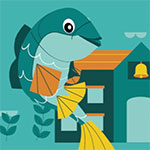Walleye Fishing Tips
This northern U.S. and Canada native fish is great to catch. Find out about the best walleye fishing spots, what walleye fishing gear to use, and other helpful information.
Fishing For Walleye
If you want to go fishing for walleye, you are in good company. Walleye are particularly rewarding to catch because they are known for being line-shy and are one of the most popular freshwater table fare fish. While walleye are native to the northern U.S. and Canada, stocking efforts have made this species accessible to freshwater anglers as far as south as Georgia.
Once you hook a walleye, don't expect a showy surface battle. Instead, prepare for a deep, stubborn fight. This species can be finicky and line-shy at times, but they aren't difficult to catch once you learn more about how to fish for walleye.
Walleye Fishing Tips
One of the most important walleye fishing tips to remember is to avoid fishing during the middle of the day or during periods of bright sunlight. If you can, plan your trip during low light conditions, around the hours of dawn or dusk. Walleye have photosensitive eyes that make it harder for them to see in bright light, so they are much more likely to become active at night or during low light conditions.
Want to learn more about how to fish for Walleye? Download our FREE e-book "Walleye Fishing Quick Guide" in partnership with Tailored Tackle.
Walleye Fishing Gear
When learning how to fish for walleye, you can use a medium to medium-heavy spinning outfit rigged with 6 to 8-pound monofilament fishing line. Since walleye often inhale their prey, light line is recommended. When you use light line, there is less drag or resistance created when the walleye attempts to strike your bait or lure. Less drag will make it easier for the walleye to take your offering.
The exception to any walleye fishing tips that recommend using light line will apply to trolling. If you plan to troll for walleye, you may want to try using medium-heavy baitcasting gear rigged with 10 to 14-pound monofilament.
Best Lures For Walleye
When selecting the best lures to use for walleye, you may want to think about the primary food sources in the waters where you plan to fish. Walleye are known to feed on yellow perch, minnows, crayfish, leeches, and a variety of insects. Consider using lures that imitate these types of food sources when walleye fishing.
- Jigs
- Minnow-imitating plugs
- Spoons
Best Rigs For Walleye
In addition to lures, you can find walleye fishing tips that will help you learn how to use a slip sinker rig, slip bobber rig, and spinner rig. These types of freshwater fishing rigs are useful when walleye fishing with live baits because they help to keep your baits off of the bottom and in the strike zone.
- Slip sinker rig
- Slip bobber rig
- Spinner rig
Best Walleye Fishing Spots
Now that you know about some of the best freshwater fishing gear and lures to use for walleye, all you have to do is find out where to catch one. When deciding where to fish for his species, it will be helpful to remember that walleye are coolwater fish. This means that while learning how to fish for walleye, it may be best to stick to large, natural lakes or rivers with average water temperatures that range from about 60 degrees to the low 70's.
- Examples of popular walleye fisheries are Lake of the Woods in Minnesota, Lake Winnebago in Wisconsin, Devils Lake in North Dakota, and the Detroit River in Michigan.
- Like most fish species, walleye are often found near structure. Try fishing near rock piles, weed beds, humps, points, and ledges.
If you want to find other lakes and rivers near you where you can enjoy fishing for walleye, you can check the places to fish and boat map.
KEEP LEARNING

First Catch Center Trailer Gallery
FCC Trailer Photo Gallery
LEARN MORE

How to Tie a Duncan Knot
Learn to tie a Duncan knot by following these five simple steps. Watch our new video.
LEARN MORE

Welcome to Angler Academy!
No one said you can’t bring fishing inside! There’s lots of fun activities we can do right from home
LEARN MORE


.png?lang=en-US&ext=.png)